Tomato variety De Barao
For a real gardener, first of all, the result of his work is important, so he tries to choose varieties that will bring the maximum return. These include the De Barao tomato. Selection work was carried out by ZAO Scientific and Production Corporation NK. LTD ". In 1998, an application was submitted for registration of the variety, and in 2000 it was entered into the State Register of Plants of the Russian Federation. All regions of Russia are suitable for cultivation. The tomato is recommended for garden plots, home gardens and small farms. Suitable for open and closed ground. Does not apply to hybrids.
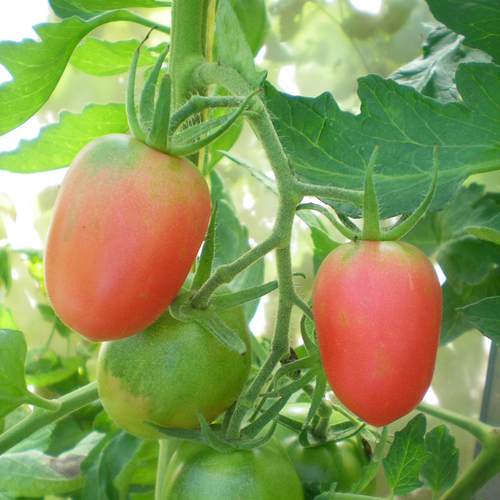
Red
Description
The plant is indeterminate, the height sometimes exceeds 2 meters. In a greenhouse, a tomato can reach 3 meters, so sometimes you have to limit growth. De Barao bush is powerful, well leafy. The stalk is thick, not fragile, slightly pubescent. The leaves are arranged alternately. The leaf blade is large, dark green, with pronounced venation, wrinkled. The internodes are long. Inflorescences are compact, drooping, can be simple or intermediate. The first fruit cluster in the variety is laid over 9-11 leaves. The next ones appear every 3 sheets. On average, about 6 - 10 brushes are formed with 5 - 6 or more ovaries in each.
The fruits are beautiful, plum-shaped, with thick walls, fleshy. Average weight - 30 grams. The skin is glossy, firm and firm, but not thick. Unripe tomato is green, there is a dark green spot near the stalk. During ripeness, the skin turns red. The pulp is juicy and tender, aromatic. There are very few seed nests - 2 or 3. De Barao's taste is excellent. The juice contains 5% dry matter and 2.8% total sugars.
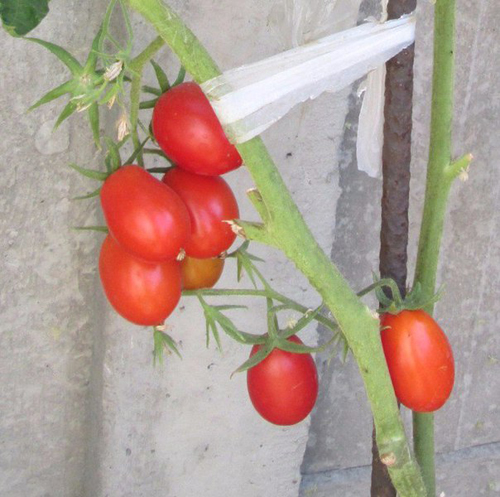
Red
Characteristics
- The variety belongs to late-ripening, as evidenced by the period from the emergence of seedlings to the beginning of ripening - it lasts 110 - 125 days;
- the yield is stable and good. According to the State Register of Plants of the Russian Federation, 5 - 6 kg of marketable products are collected from 1 square meter. According to other sources, the yield from the same area is 5.4 - 6.8 kg;
- fruiting can last almost until the very frost;
- De Barao perfectly adapts to growing conditions, easily tolerates stressful situations, is not afraid of cold snaps, can grow and bear fruit in low light;
- even during the period of prolonged rains, the peel on tomatoes does not burst;
- disease resistance is very high. Only sometimes in a weak degree can a tomato be affected by late blight;
- thanks to the strong skin, the transportability of the fruit is very high;

Orange
- the keeping quality of tomatoes is excellent. The harvested crop, subject to storage standards, is stored for up to 2 months without losing its presentation;
- if you had to harvest not fully ripe, it does not matter. De Barao tomatoes ripen well in the warmth and do not lose their characteristic taste;
- the way of using the fruits of this variety is universal. They can be consumed in their natural form, they are excellent for pickling and are considered one of the best for whole-fruit canning. But it will not be possible to get juice from them - the pulp is dense and low-liquid.
Agrotechnics
It is preferable to grow by seedling method. Sowing time is the first or second decade of March, depending on the region. In early May, the seedlings begin to harden, preparing them for transplantation. Young plants are transplanted to a permanent place at the age of 60 - 70 days. If in open ground the temperature drops below 10 ° C, then you need to make a shelter from a film or agrofiber.
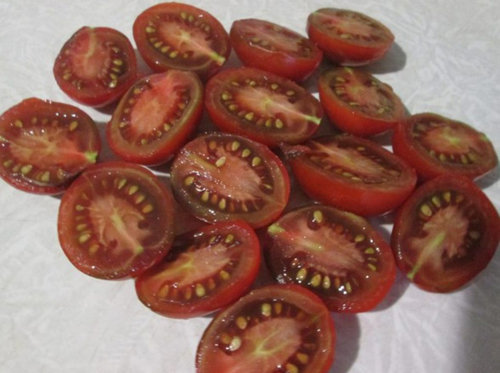
The black
Given the tallness and spreading of the variety, the De Barao planting scheme is somewhat different from the standard one. Leave 80 cm or more between seedlings in a row. Row spacing - 100 - 120 cm. Planting density - no more than 2 - 2.5 bushes per 1 square meter.
Watering is carried out approximately once a week, taking into account weather conditions. Top dressing is also necessary, because the tomato spends a lot of energy on the growth and formation of fruit clusters.Mineral fertilizers can be alternated with organic matter.
De Barao is formed most often in 1 stem, sometimes in 2. Stepson formed in leaf nodes must be removed. The bush is tied to a vertical support and, if necessary, limit growth by cutting off the top. A strong outdoor crop is often planted along wooden fences, which are then used as a support.
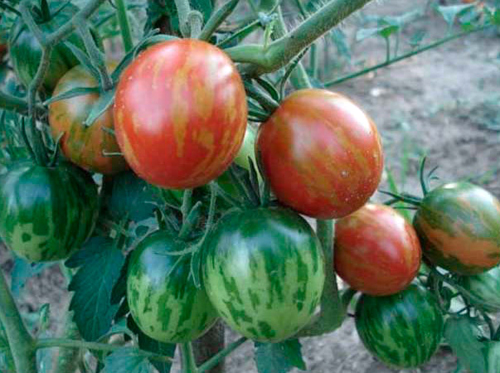
Striped
Varieties
Our hero has several varieties that are no less popular than the main variety. They have the same excellent characteristics, and on some points even surpass their eminent namesake. The most famous of them are included in the State Register of Breeding Achievements of the Russian Federation.
De Barao gold - LLC “Gisok Seed-Breeding Firm” was registered in 1997. Included in the State Register of Plants of the Russian Federation in 1998. Ripens 120 days after germination. The admission to cultivation is available in all regions of Russia. The tomato is recommended for garden plots, home gardens and small farms. It is used for growing in the spring-summer turnover under film shelters. The plant is indeterminate - more than 2 meters in height, therefore it requires a garter. Strong branching, good foliage. The leaf plates are large, ordinary, medium-corrugated, matte. The inflorescence of the variety is simple, loose. The first inflorescence is formed over 9 - 11 leaves, the next - after 3 leaves. The fruit is oval, smooth. Weight - 79 - 83 grams. When unripe, it has a green spot at the stalk. The ripe fruit turns into an even yellow color. The taste is great. The yield of marketable products is 6.2 - 6.4 kg per 1 square meter. Tomato blight is weakly affected by late blight. The fruits are suitable for natural consumption and for whole-fruit preservation.
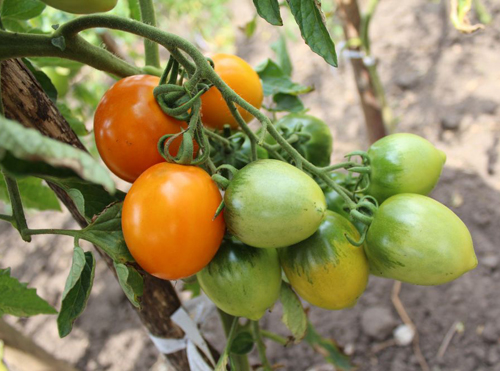
Gold
De Barao orange - created by the same company in 1998, entered into the State Register in 1999. Suitable for growing in all regions of Russia. Late maturing. Recommended for personal subsidiary and small farms. The plant is indeterminate, with medium-sized leaves and a simple inflorescence. The first fruit cluster is laid over 9-11 leaves, the rest - after 3 leaves. The fruits are ovoid, with an average weight of 65 grams. An unripe tomato has a dark spot at the stalk, when ripe it turns orange. Good taste. The marketable yield is high - 8 kg per 1 square meter. The variety is highly resistant to late blight. Tomatoes are dense, suitable for transportation and for whole-fruit canning.
De barao pink - this tomato was presented by Gisok in 1997, a year later it was entered into the State Register with admission in all regions of Russia. Recommended for garden plots, home gardens and small farms. Suitable for growing in spring and summer under a film cover. Ripens in 117 days after germination. The plant is indeterminate, 2 meters in height, medium-branched, foliage is small, internodes are long. The leaf plate is ordinary, slightly wrinkled, the inflorescence is simple, compact. The fruit cluster is laid over 9-11 leaves, the subsequent ones - every 3. Fruit is oval, smooth. Weight - 50 - 70 grams. An unripe fruit has a dark spot at the stalk, the pulp and skin of the ripe one turns pink. The taste is good. The yield of marketable fruits is 5.4 - 6.8 kg per 1 sq. meters. The value of tomato lies in its high yield, good taste and suitability for canning.
De Barao black - another version from the firm "Gisok". Date of filing an application for registration - 1998, entered into the State Register in 1999. Approved for cultivation in all regions of Russia. Recommended for garden plots, home gardens and small farms, suitable for open ground and unheated greenhouses. The variety is late ripening. Indeterminate bush, medium leafy. The inflorescence is simple. The first fruit cluster is laid over 9-11 leaves, the rest - every 3. Fruits are ovoid, weighing 58 grams. The dark green spot in an unripe fruit disappears at the moment of full ripeness, the skin turns purple-brown. Good taste. The yield is excellent - 8 kg per 1 sq.meters. Susceptibility to late blight is weak. The tomato is suitable for whole-fruit canning.
De Barao royal - this variety is the development of Agrofirma Aelita LLC. A new variety, announced in 2016, entered into the State Register in 2018. Recommended for growing in private farms in the open field or under a film shelter in all regions of Russia. The tomato is mid-season. The plant is indeterminate, the leaf plate is long, the inflorescence is complex. The fruit is elliptical, dense, slightly ribbed, weighing 150 grams. There is no dark spot at the peduncle; when mature, the tomato turns red. The taste is good. Under a film cover, the yield of marketable fruits is 11 kg per 1 sq. meters.
De Barao striped - indeterminate variety, has increased resistance to late blight. Fruits are oval-ovoid, weighing 60 -70 grams. Ripe tomato is red with unusual yellow stripes-spots. Fruit cluster contains 5 - 10 ovaries. Ripening period is medium late (120 - 130 days).
Our hero is appreciated for stable and long-term fruiting. The plant is resistant to disease and climate change, making it easy and enjoyable to grow. Strong skin and dense flesh allow tomatoes to be transported over long distances or stored. De Barao is also appreciated for its excellent taste and the possibility of using it for whole-fruit canning. Another plus is the ability to independently harvest seed from the main variety and its varieties.
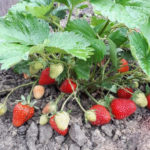
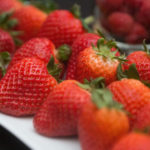
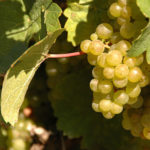
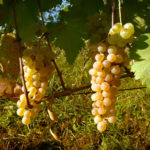
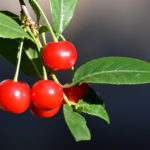
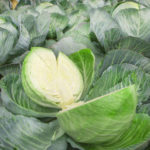



For the first time I saw De Barao pink tomatoes at my mother-in-law and the next year I found seeds in the store. Before sowing, I soaked it briefly in a solution of potassium permanganate. They sprout well. After 4 leaves I dive. I put soot in a permanent place in mid-May under agryl. I drive in stakes after the bushes have taken root, and frosts are no longer threatening (sometimes even in the first half of June we may have frosts). The mother-in-law does not tie, but cuts off the bushes at a height of about 1 m, and does not cut off the stepsons. To be honest, her technology is strange, but the harvest is always great. On the contrary, I am the stepson, leaving 2 - 3 shoots, and tying them up. The bush is really about 2 meters. Some hands have to be tied up. tomatoes are large and sometimes come off with the entire brush. I pick the fruits at half ripeness, they ripen at home in a couple of days. The taste is more sweet, slightly sour. Very fleshy, firm. The rind is smooth and not thick. There are no gnarled fruits. They make excellent cobra and thick tomato juice. They require abundant watering, feeding with superphosphate, mullein infusion. They write that they are shade-tolerant. It's true. But the harvest is better if planted in sunny places.
I like the variety very much. For the first time, by chance, a friend gave black seedlings to De Barao. The fruit is medium in size, fleshy and very sweet. Then I bought the seeds myself, planted them and I already distributed the seedlings to my friends. Everyone was delighted. A few years later, in the store I saw seeds not only black De Barao, but also pink and yellow. Plants and growing conditions are the same, fruits of all varieties are very sweet and fleshy. The difference in the three varieties is only in the color of the skin of the fruit. Since then I have been planting all three types of De Barao: black, yellow, and pink. I advise everyone to try it.
If your greenhouse is not high, then you should not plant De Barao black.It grew more than 2 meters for me, I think it would be even taller, but it pinched off the top of the plant. I tried to form a plant in both two and one stem. Fruits grow larger in one stem. Usually the plant produces 8 - 10 brushes of 8 - 16 tomatoes the size of a large plum in one stem. They ripen quickly and amicably, it is enough for the tomatoes to darken a little and that's it, they are already ripe. Sweet to taste, no sourness. The fruits are stored for quite a long time. At the end of the season, they pick up brown spot, but with it all the fruits ripen. The plant gives a lot of stepchildren, which must be constantly cut off. Good grade.
I love De-barao tomatoes very much, especially pink. I plant my own seedlings, usually in early May. Somewhere in the middle of June, I tie up and cut off the lower shoots. This is not a super early variety, but it bears fruit for a long time. This year we were pleased, there was no frost, so the tomatoes were available until mid-October. I grow it mainly for conservation. I think that there is no better variety for this purpose. Smooth, neat, almost the same size. They fit into the neck of the can, even if they are a little too big. I pour boiling water 2 times, but I think that after 3 times they will not come apart. The only drawback for me is that there are very few seeds inside. You have to crush more than one tomato in order to collect at least something for planting next year.
But I don't really like this variety - I like tomatoes with large, fleshy fruits, which are good for fresh consumption. And De-barao's pink tomatoes are too small. But this size is great for canning - they fit perfectly into the jar. But the taste of the fruit with a noticeable sourness is not saved even by the addition of sugar during conservation. But the variety has obvious advantages - a lot of fruits are always tied (sometimes it even seems to me that the pollen does not react to high temperature and dry air), the tomatoes are not watery - dense, do not crack, the tomato is also more or less resistant to diseases (late blight is affected only in very cold and rainy summers). I can also refer to the disadvantages - the high growth of the bush (if you grow De-barao in a greenhouse, this is more likely a "plus", and for open ground - a big minus, since the "windage" of the bush increases, and often with gusts of wind or abundant watering bushes fall). Another of the minuses is the tendency to a large formation of "green mass" (stepsons and leaves): you have to constantly cut off both, otherwise the yield drops sharply.